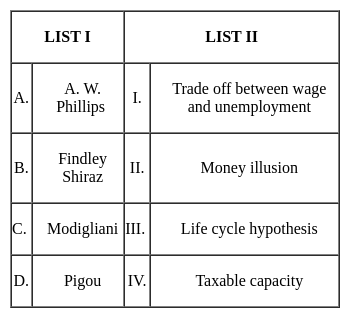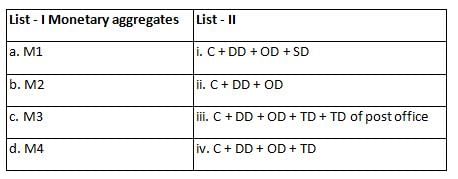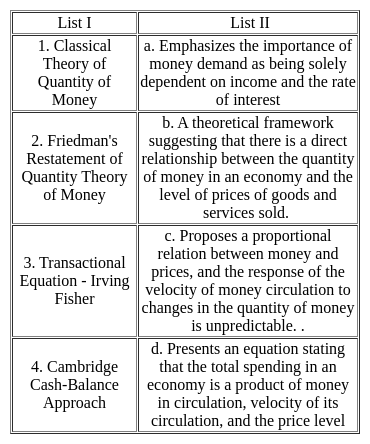UGC NET Paper 2 Economics Mock Test - 1 - UGC NET MCQ
30 Questions MCQ Test - UGC NET Paper 2 Economics Mock Test - 1
With reference to Economic Survey 2022-23, consider the following statements regarding Liquidity:
1. Surplus liquidity conditions that prevailed post-Covid-19 in response to the Reserve Bank’s conventional and unconventional monetary measures moderated during FY23
2. Hike in the Cash Reserve Ratio results in the withdrawal of primary liquidity from the banking system.
Which of the statements given above is/are correct?
Which of the following are the fiscal policy measures taken by the government to control inflation?
1. Reduction in public expenditure and public borrowing.
2. Increasing taxes on private businesses.
3. Increasing interest rates in the economy.
Select the correct answer using the code given below.
Based on which index, the study finds convergence with HDI in the passage ?
Cardinal utility analysis of consumer's behaviour is based on which combination of the following assumptions:
(i) Utility is measurable in terms of cardinal number.
(ii) Constancy of the marginal utility of money
(iii) Utilities of different goods are interdependent
(iv) Marginal utility of a good for a person diminishes with every increase in the stock that he already has.
Choose the correct answer from the code given below:
Match List I with List II

Choose the correct answer from the options given below:
With reference to the fiscal drag, consider the following statements:
1. It is an economic term whereby inflation or income growth moves taxpayers into higher tax brackets.
2. It is essentially a slowing in the growth of the economy caused by a lack of spending as increased taxation slows the demand for goods and services.
3. It is common to view fiscal drag as a natural economic stabilizer as it tends to keep demand stable and prevent the economy from overheating.
Which of the above statement is/are correct?
With reference to the Indian economy, consider the following statements:
1. A treasury bill is a promissory note issued by the Reserve Bank of India to meet the long-term requirement of funds.
2. Call money is mainly used by the banks to meet their temporary requirement of cash.
3. Commercial paper is an unsecured, short period debt tool issued by a company, usually for the finance and inventories and temporary liabilities.
Which of the statements given above is/are correct?
By what percent India's exports declined during February-2015?
He described economics as a science of material welfare
The first bi-monthly monetary policy statement for fiscal year 2015-16 was released in which month?
How many MoUs have been signed between India and United States on 25th Jan 15 as part of Indian Government ambitious “Smart Cities” Scheme?
With reference to the Indian economy, demand-pull inflation can be caused/increased by which of the following?
1. Expansionary policies
2. Fiscal stimulus.
3. Inflation-indexing wages
4. Higher purchasing power
5. Rising interest rates
Select the correct answer using the code given below.
The Multi-dimensional Poverty Index developed by Oxford Poverty and Human Development Initiative with UNDP support covers which of the following?
1. Deprivation of education, health, assets and services at the household level.
2. Purchasing power parity at the national level.
3. Extent of the budget deficit and GDP growth rate at the national level.
Select the correct answer using the codes given below:
In the context of Indian economy, consider the following statements:
1. The growth rate of GDP has steadily increased in the last five years.
2. The growth rate in per capita income has steadily increased in the last five years.
Which of the statements given above is/are correct?
Directions: Read the given statements carefully and choose the correct option accordingly.
Assertion (A): In liquidity trap, the demand for money is perfectly interest elastic.
Reason (R): Because in this situation, all the investors expects the market rate of interest to rise towards the natural rate of interest
Directions: The candidates are required to match List - I against List - II and select the correct answer code.

Goods for which demand move in the opposite direction of the income of the consumer are called?
“Soft infrastructure” has been in the news in the context of developed as well as developing countries. Which of the following statements is/are correct regarding this?
1. It covers a broad range of fiscal, monetary, financial policies and statistics.
2. The education system, the health care as well as emergency services are part of the hard infrastructure.
Select the correct answer from the codes given below.Due to distress in agriculture sector, the government can face which of the following demands from the farmers?
Which one of the following is not the basic property of indifference curves ?
Which of the following is/are not the assumption(s) of Walter's dividend model?





















